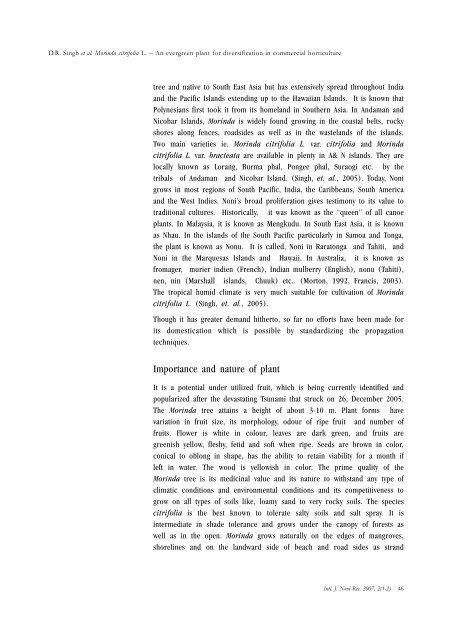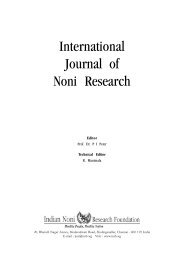International Journal of Noni Research - Noni Family
International Journal of Noni Research - Noni Family
International Journal of Noni Research - Noni Family
You also want an ePaper? Increase the reach of your titles
YUMPU automatically turns print PDFs into web optimized ePapers that Google loves.
D.R. Singh et al. Morinda citrifolia L. – An evergreen plant for diversification in commercial horticulture<br />
tree and native to South East Asia but has extensively spread throughout India<br />
and the Pacific Islands extending up to the Hawaiian Islands. It is known that<br />
Polynesians first took it from its homeland in Southern Asia. In Andaman and<br />
Nicobar Islands, Morinda is widely found growing in the coastal belts, rocky<br />
shores along fences, roadsides as well as in the wastelands <strong>of</strong> the islands.<br />
Two main varieties ie. Morinda citrifolia L. var. citrifolia and Morinda<br />
citrifolia L. var. bracteata are available in plenty in A& N islands. They are<br />
locally known as Lorang, Burma phal, Pongee phal, Suraogi etc. by the<br />
tribals <strong>of</strong> Andaman and Nicobar Island. (Singh, et. al., 2005). Today, <strong>Noni</strong><br />
grows in most regions <strong>of</strong> South Pacific, India, the Caribbeans, South America<br />
and the West Indies. <strong>Noni</strong>’s broad proliferation gives testimony to its value to<br />
traditional cultures. Historically, it was known as the “queen” <strong>of</strong> all canoe<br />
plants. In Malaysia, it is known as Mengkudu. In South East Asia, it is known<br />
as Nhau. In the islands <strong>of</strong> the South Pacific particularly in Samoa and Tonga,<br />
the plant is known as Nonu. It is called, <strong>Noni</strong> in Raratonga and Tahiti, and<br />
<strong>Noni</strong> in the Marquesas Islands and Hawaii. In Australia, it is known as<br />
fromager, murier indien (French), Indian mulberry (English), nonu (Tahiti),<br />
nen, nin (Marshall islands, Chuuk) etc.. (Morton, 1992, Francis, 2003).<br />
The tropical humid climate is very much suitable for cultivation <strong>of</strong> Morinda<br />
citrifolia L. (Singh, et. al., 2005).<br />
Though it has greater demand hitherto, so far no efforts have been made for<br />
its domestication which is possible by standardizing the propagation<br />
techniques.<br />
Importance and nature <strong>of</strong> plant<br />
It is a potential under utilized fruit, which is being currently identified and<br />
popularized after the devastating Tsunami that struck on 26, December 2005.<br />
The Morinda tree attains a height <strong>of</strong> about 3-10 m. Plant forms have<br />
variation in fruit size, its morphology, odour <strong>of</strong> ripe fruit and number <strong>of</strong><br />
fruits. Flower is white in colour, leaves are dark green, and fruits are<br />
greenish yellow, fleshy, fetid and s<strong>of</strong>t when ripe. Seeds are brown in color,<br />
conical to oblong in shape, has the ability to retain viability for a month if<br />
left in water. The wood is yellowish in color. The prime quality <strong>of</strong> the<br />
Morinda tree is its medicinal value and its nature to withstand any type <strong>of</strong><br />
climatic conditions and environmental conditions and its competitiveness to<br />
grow on all types <strong>of</strong> soils like, loamy sand to very rocky soils. The species<br />
citrifolia is the best known to tolerate salty soils and salt spray. It is<br />
intermediate in shade tolerance and grows under the canopy <strong>of</strong> forests as<br />
well as in the open. Morinda grows naturally on the edges <strong>of</strong> mangroves,<br />
shorelines and on the landward side <strong>of</strong> beach and road sides as strand<br />
Intl. J. <strong>Noni</strong> Res. 2007, 2(1-2) 46








